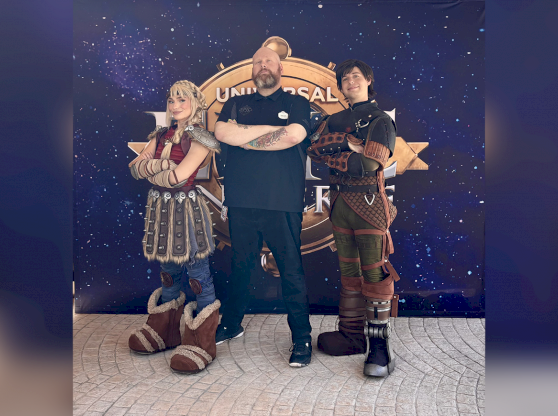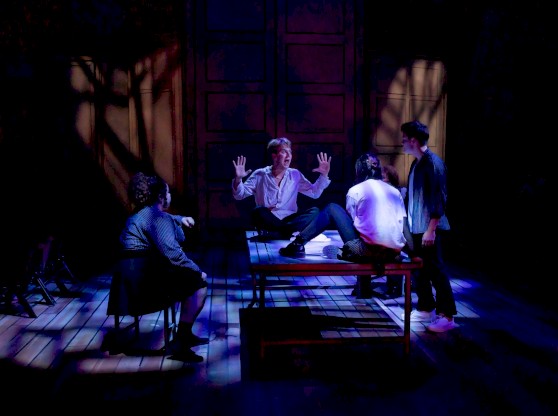What can a costume communicate? In her lecture at the TEDxUF: Solstice Conference in March, 2022, professional costume designer and educator in the University of Florida School of Theatre + Dance, Jennifer Dasher, explains that we have a responsibility to deeply consider the impact that an image, and the costuming that is central to defining it, can create.
In the Loop recently interviewed Dasher to learn more about her varied career path as a costume designer for productions ranging from community theatre to Cirque du Soleil, and everything in between, and as an educator. Dasher also shares insights into the effects the COVID-19 pandemic has had on the costume design industry.
Loop: Can you share how you found your way into the field of costume design?
Jennifer Dasher: I enjoyed doing theatre in high school, but it wasn’t my sole focus. I also played soccer, softball, and basketball; I was on the speech and debate team, too — all the things a high schooler does. In college, I declared my major in political science right off the bat, but I quickly found that I was bored in my classes — although now, I think I would be super interested in a political science class!
I was also taking an intro to theatre course. I was really drawn to the class, but I knew I wasn't a performer. Somehow in there, I found my way to the costume world, and it just lit me on fire in a really interesting way. I’ve always been interested in storytelling and psychology. When we get dressed in the morning, what we choose to wear often says something about us. Sometimes it says, ‘I'm picking the shirt up off the floor because I don't have time to deal with this.’ But usually, when we go out and enter the world, we've thought about the clothes that are going on our body. There's psychology intertwined into clothing, and into character, that I find interesting.
Loop: And once you got into costume design, what did your career path look like?
JD: It really has changed and shifted a lot throughout the years!
I’m in my fifth year at the University of Florida, but directly prior to being at UF, I was working as a professional designer. Before that, I had been at the University of Maryland and North Carolina State University, but I took a break from education to just work and expand as an artist. The intensive experience as a freelancer has become the research for a book about collaboration that will be published this year.
One of the things I’ve recognized as a creative individual is: once we're grounded in our own skills, we can successfully work in different environments. Most of my design work has been in live entertainment, but within live entertainment there's anything from a small regional theater, or a dance company located in a smaller city, to huge rock concerts — think: Taylor Swift, Madonna — and there's everything in between.
I’ve discovered that with those rooted skills and a grounded understanding of who I am: I can be a chameleon. I can work with the small dance company, or on the huge project — and I understand my role and my contribution to both.
Loop: What aspects of your work continue to stoke “fire” for design that you discovered in your undergrad?
JD: When you're relying onyour artistry to make a living, it's really figuring out: okay, if I want to do this smaller dance piece because I love the content, or because I love the choreographer — then, I might need to balance that out by doing a huge show where my role is perhaps a little bit smaller, or I don’t have as much creative freedom.
As a designer, I like figuring out: ‘what is it about this project that invigorates me?’ There's always something — even if that something is, ‘well, we have to figure out how to source and create and costume 40 actors on a $2,000 budget.’ Most designers don't want that to be their entire career — but for me, that work can be just as thrilling as the bigger budget, higher profile things. What projects I choose comes down to who I will be collaborating with and what the story is we are trying to tell.
Loop: You mentioned that you started out teaching at the Universities of Maryland and North Carolina State before doing professional design. What drew you to education?
JD: My mother was a teacher, and my grandmother was a teacher — so education was always communicated to me as ‘the way to change things’ … I believe the arts change the world, and I believe education changes the world — so I’m drawn to the ability to combine those, and to be able to send students out into the world to make impact and change.
Loop: Congrats on five years at the University of Florida! Can you talk about your time here?
JD: There's this thrust behind everything that the UF College of the Arts is doing that’s been really expansive for me, both as an artist and as a human being.
I think across all areas [at the School of Theatre + Dance], we are really looking at systemic ways that curriculum has been designed to hold certain populations back and/or only tell certain stories — and how we can disrupt that.
If you take costume history, for example: in almost every university in the United States, it's taught from the beginning of time to modern day, in the same sequence. You get the terminology and the visual: male and female costume history, and maybe children’s [costume history]. It's very formulaic — to the point where I could, today, pull out my notes from graduate school 15 years ago and teach the same course.
But as a costume designer, if you can Google and in five seconds determine what a female-presenting character from the 1920s would wear — I don't need to teach you that. You don't need to pay the University of Florida to teach you that. There’s a lot of opportunity, here, to disrupt that formulaic structure.
Our approach, here, is: what is the information we can present that you can't find on your own What are the skills and ways of thinking that we need to push forward to move students into the next era?
Loop: During your time at UF, you’ve also continued working as the costume designer for productions in New York. The COVID-19 pandemic put much of that work on hold (as it did for so many artists). As things are going “back to normal,” or perhaps a “new normal” in 2022 — can you speak to how the pandemic affected the costume industry?
JD: I think the most interesting thing is the advocacy the industry has started on its own behalf. John Kristiansen and Brian Blythe who own a couture costume shop in New York started the Costume Industry Coalition while the industry was collapsing. Their immediate goal at the time was: how do we stay afloat? How are we ever going to come out of this without having to change careers?
Most people would be surprised that even those high-end costume shops in New York that are doing Broadway shows — they don't really profit from those shows. They break even. It takes a lot for one of those shops to get on the right side of the profit spectrum.
The Costume Industry Coalition comprised of small and large shops as well as adjacent businesses joined together to start looking at business practices and their impact on a broad scale … they started looking at pay rates, for example, which have been, historically, very low for costume designers and in costume shops — which is something that is rooted in misogyny.
In general, everyone started to assess: ‘Why am I doing this in this way? What is it getting me? What are the values of my time?’ When you suddenly stop running around trying to get everything done on a deadline, you have all this time to assess and potentially reprioritize. For the industry to return to full capacity, substantial change was required in the way peopleand the work is valued.
Of course, without actually being in those costume shops — it's hard to tell, yet, what has actually changed [since 2020]. But I think now comes real work that, hopefully, we will continue toward: antiracism, equity, diversity, and inclusion in the industry.
Youtube: Why Is Anyone Listening To Me? | Jennifer Dasher | TEDxUF
Dasher’s upcoming book is titled, Bringing Set and Costume Designs to Fruition: Made by Teams. It isco-authored by Lynne Koscielniak, Professor of Scenography in the Department of Theatre and Dance at the University at Buffalo and Jonathan Shimon, associate professor of Theatre Technology in the Department of Theatre and Dance at the University at Buffalo.


